Do Aussiedoodles shed? And are Aussiedoodles hypoallergenic? These are the questions that many of you might be asking before taking the huge leap of adopting an adorable Aussiedoodle puppy. As you might know, one of the biggest appeals of Doodles like the Aussiedoodle is that they’re considered very low to non-shedding dogs, perfect for people with allergies. In addition to that, they’re extremely fun-loving and affectionate pups with super high intelligence levels. Sounds like the perfect dog, am I right?! In this article, we’re going to learn more about the Aussiedoodle shedding levels, causes, prevention, and how you can combat excessive shedding. Let’s dig in!
Table of Contents
- Do Aussiedoodles Shed? Are Aussiedoodles Hypoallergenic? Here’s The Answer You’ve Been Looking For…
- How Can I Tell If My Aussiedoodle Will Shed? Different Types Of Aussiedoodle Coats & Their Potential For Shedding
- How Much Do Aussiedoodles Shed?
- When Do Aussiedoodles Shed the Most?
- Can Aussiedoodle Shedding Be Caused By Certain Health Issues?
- Common Allergic Reactions In Humans
- Tips For Managing Allergic Reactions & How To Minimize Aussiedoodle Shedding
- Do Aussiedoodles Shed? FAQ
- Do Aussiedoodles Shed? Final Thoughts
Do Aussiedoodles Shed? Are Aussiedoodles Hypoallergenic? Here’s The Answer You’ve Been Looking For…
Contrary to popular belief, Aussiedoodles can shed some amount of hair. This means that not all Aussiedoodles are hypoallergenic and non-shedding, as many would like to claim. But all in all, Aussiedoodles are hypoallergenic dogs, at least considered to be by many.
To be fair, there’s no such thing as a completely non-shedding and hypoallergenic dog. Even purebred Poodles shed! The main difference is that Poodles have single-layered coats and their curly hair traps in any loose fur, preventing it from falling out of the fur and ending up on your clothes, furniture, floors, and carpets.
For this reason, Aussiedoodles do have a great advantage compared to many other breeds – even the purebred Australian Shepherd parent. Thanks to the Poodle in their lineage, Aussiedoodles benefit from a more allergy-friendly coat, which has proven to be a great option for many people who struggle with dog allergies. (Or, people who just prefer a pup who’d leave less hair around the house.)
On that note, there’s a common misconception that dog hair is what causes allergies, but it’s actually the dander, saliva, and even urine. Naturally, dog hair is the perfect place for the saliva and dander particles to settle into. And if you’ve got a heavy shedder, your whole house will be filled with all of those tiny triggering particles.
Of course, even low-shedding breeds will lick themselves and have dog dander. However, as they shed very minimally, they won’t leave nearly as much dog dander, saliva, and urine particles on your furniture or floors. And that’s what makes Doodles such a great choice for people who suffer from allergies.
But what about smaller Doods – do Mini Aussiedoodles shed?
Regardless of their size, even Mini Aussiedoodles can shed hair, especially if they’re double-coated. At the end of the day, this is determined by their coat type and genetics. However, one interesting fact about Mini Aussiedoodles is that if they’ve been bred as backcross generations, they’re much less likely to inherit more of the Poodle’s traits and characteristics. If that’s the case, then there’s a smaller chance of those backcross Mini Aussiedoodles shedding.
Nonetheless, be very wary of breeders who claim to have non-shedding and hypoallergenic Aussiedoodles, as there’s always a chance these pups inherit a shedding undercoat. Indeed, some Aussiedoodles do shed hair, and this is determined by their coat type and genetics. Let’s now cover the main types of Aussiedoodle coats and how they can affect your Aussiedoodle’s shedding levels.
How Can I Tell If My Aussiedoodle Will Shed? Different Types Of Aussiedoodle Coats & Their Potential For Shedding
An Aussiedoodle’s potential for shedding is directly linked to their coat type. Some Aussiedoodles can shed considerable amounts of fur throughout the year, whereas others might shed very minimally – it’s all down to their coat type and whether they’re single or double-coated.
Like other Doodles, we can never know for sure how an Aussiedoodle might turn out. As we’re combining two purebred dogs, the Australian Shepherd and Poodle, we can also expect a variety of outcomes, namely in their appearance in terms of coat types and shedding. Let’s take an in-depth look.
Aussiedoodle Curly Coat
The most desired Aussiedoodle coat type in terms of shedding is the curly coat. Resembling most of the Poodle parent, Aussiedoodles with this coat type tend to shed the least. They’re typically single-coated with plush, curly hair. On the other hand, the Aussiedoodle curly coat requires the most maintenance out of the three. As their textured curly hair can easily become knotted and also trap in loose hair, dirt, and debris, they are the most prone to matting. For curly coat Aussiedoodles, daily brushing is an absolute must.

Aussiedoodle Wavy Coat
Also a popular choice, the Aussiedoodle wavy coat is a beautiful combination of the straight Australian Shepherd coat and the curly-haired Poodle. The wavy coat may or may not be double-layered, but it typically sheds very little thanks to the Poodle genes in the mix. And as the hair isn’t as curly and textured, it’s usually much easier to maintain than the curly coat.
Keep in mind, however, that single-coated Aussiedoodles shed much less than double-coated Doods. So, if you’re one of those lucky people whose wavy-coated Aussiedoodle has only a single layer of fur, you can expect minimal shedding. In contrast, if your wavy-coated Aussiedoodle is double-coated, be prepared for some shedding.
Aussiedoodle Straight Coat
Lastly, we have the straight coat Aussiedoodle who inherits its hair mostly from the Australian Shepherd parent. Most commonly, pups with the straight coat also come with an insulating undercoat. The downside of this coat type is that it tends to shed considerably more than the other two coat types, especially during shedding seasons. Although straight-haired Aussiedoodles aren’t as prone to matting, you’ll still want to routinely brush out the loose dead hair that’s trapped beneath the thick layers of the double coat.
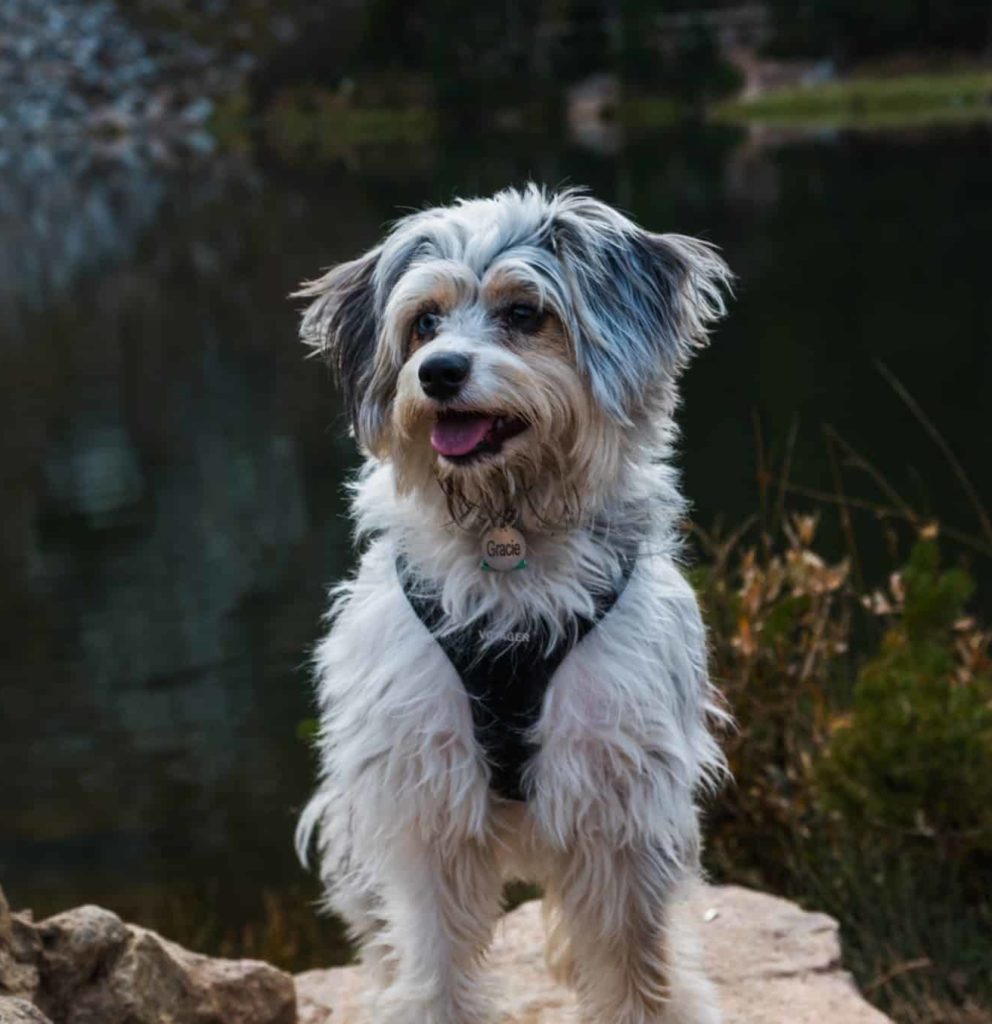
How Much Do Aussiedoodles Shed?
How much does an Aussiedoodle shed? Are Aussiedoodles a good choice for allergic people? Although Aussiedoodles with straight and wavy hair can shed, we can expect them to shed much less than the purebred Australian Shepherd parent. Thanks to the Poodle genes in the mix, all Aussiedoodles are considered low to non-shedding dogs. Of course, double-coated Aussiedoodles can shed some hair, especially during shedding season. However, you can easily combat this with regular brushing and coat maintenance.
Genetics and Hair Types: Comparing Generations & Aussiedoodle Hypoallergenic Levels
As we already mentioned, it all boils down to an Aussiedoodle’s genetic makeup and hair type. Hybrid breeds with Poodle in the mix all benefit from less shedding. However, if an Aussiedoodle takes more after the Australian Shepherd, we can expect them to shed more than Aussiedoodles taking after the Poodle parent.
All in all, understanding their generation gives us a pretty good estimate about an Aussiedoodle’s shedding levels and their hypoallergenic potential. Reputable breeders often produce either one or multiple generations of Aussiedoodles. Here’s what they mean exactly:
| 1st Parent | 2nd Parent | % Australian Shepherd* | % Poodle* | |
| F1 Aussiedoodle (first-generation) | Australian Shepherd | Poodle | 50% | 50% |
| F1B Aussiedoodle (first-generation backcross) | F1 Aussiedoodle | Poodle | 25% | 75% |
| F1BB Aussiedoodle (first-generation backcross backcross) | F1B Aussiedoodle | Poodle | 12.5% | 87.5% |
| F2 Aussiedoodle (second-generation) | F1 Aussiedoodle | F1 Aussiedoodle | 50% | 50% |
| F2B Aussiedoodle (second-generation backcross) | F1 Aussiedoodle | F1B Aussiedoodle | 37.5% | 62.5% |
| F2B Aussiedoodle (alternate cross) | F2 Aussiedoodle | Poodle | 25% | 75% |
| F3 / Multigen Aussiedoodle | F1B Aussiedoodle or higher | F1B Aussiedoodle or higher | Varies | Varies |

So, based on the information above, which Aussiedoodle is the most hypoallergenic and sheds the least? Is an F1 Aussiedoodle hypoallergenic? What about F1b Doods? Let’s take a closer look…
Are F1 Aussiedoodles Hypoallergenic?
F1 Aussiedoodles are first-generation offspring of a purebred Australian Shepherd and purebred Poodle. F1 Doodles have a 50-50 mix of both parental breeds, meaning that it’s rather tricky to predict how these pups will turn out. Is an F1 Aussiedoodle hypoallergenic? That depends entirely on what coat type they’ve inherited.
Typically, F1 Aussiedoodles are more likely to have wavy than curly coats. Some pups may also have undercoats that typically shed. For this reason, F1 Aussiedoodles are more suitable for people with mild allergies, as these pups may shed a little.
Are F1b Aussiedoodles Hypoallergenic?
F1b Aussiedoodles are considered more hypoallergenic than F1 or F2 Doodles. That’s because these pups have a mix of 75% Poodle and 25% Australian Shepherd in their lineage. Most commonly, breeders produce F1b generations by crossing an F1 Doodle back to a Poodle (some also use the other purebred parent, but that’s quite rare).
Obviously, we can expect these Doods to take more after the Poodle parent in terms of their coat type and hypoallergenic levels. Therefore, F1b Aussiedoodles are better suited for people with moderate to severe allergies.
Are F1bb Aussiedoodles Hypoallergenic?
Then there’s also the F1bb, or first-generation backcross backcross Aussiedoodle. These pups have a F1b Aussiedoodle parent and a Poodle parent. With a whopping 87.5% of Poodle in their genetic makeup, it’s safe to assume that these pups inherit most of the Poodle traits.
So, we can consider F1bb Aussiedoodles more hypoallergenic than both F1 and F1b generations, making them an excellent choice for people with severe allergies.
Are F2 Aussiedoodles Hypoallergenic?
F2 Aussiedoodles have a similar genetic makeup to F1 Aussiedoodles, as they have two F1 Doodles as parents. Again, these Doods have a 50-50 mix of both the Australian Shepherd and Poodle. Needless to say, it can be difficult to predict how these pups may turn out.
Overall, F2 Aussiedoodles may not be as hypoallergenic as backcross generations like F1b, F1bb, F2b, and F2bb. On the other hand, if a breeder crosses two F1 Aussiedoodles with low to non-shedding coats, it’s more likely that their offspring will inherit this trait.
Are F2b Aussiedoodles Hypoallergenic?
Second-generation backcross, or F2b Aussiedoodles are again a safer choice for people with allergies. Like the F1b Aussiedoodle, F2b Doods have more Poodle in their bloodline, about 75%. For this reason, we can consider F2b Aussiedoodles hypoallergenic.
Are F2bb Aussiedoodles Hypoallergenic?
And finally, the F2bb Aussiedoodle also has a much higher percentage of Poodle in their genetic makeup. They have an F2b Aussiedoodle parent and a Poodle parent, meaning that the majority of their traits are likely going to be influenced by the Poodle heritage. These pups typically come with curly coats and they’re the safest option for people with severe allergies.
When Do Aussiedoodles Shed the Most?
Why do some Aussiedoodles shed more than others? Do Aussiedoodles shed more during certain times of the year? Do Aussiedoodles blow their puppy coat?
Time of Year
Aussiedoodle shedding is also often determined by the time of the year. Namely, seasonal changes like warm to cold weather, or cold to warm weather. Like the Australian Shepherd, double-coated Australian Shepherds might experience more shedding once their coat transitions from one season to another. Luckily, even straight-haired Aussiedoodles shed less than the purebred Australian Shepherds. However, you might still notice more loose hair around the house during seasonal shedding.
Puppy Coat
Like other dogs, Aussiedoodles blow out their puppy coat in their first year of life. They typically start transitioning into their adult coats between 4 and 6 months old. Sometimes even slightly later than that. In their early months, Aussiedoodles sport a softer puppy coat, which they’ll soon shed. The puppy coat is replaced with a thicker adult coat that’s going to stay the same throughout their life.
For some Aussiedoodles, the transition is almost seamless, and you won’t notice any patches of loose hair around the house. Neither will you notice different patches of hair on their body. In contrast, other pups go through more rapid stages of transition from a puppy coat to an adult coat. In fact, it’s not uncommon for Aussiedoodles to sport a much different fur compared to their puppy coat once they become adults.
Can Aussiedoodle Shedding Be Caused By Certain Health Issues?
In addition to their genetic makeup and coat types, Aussiedoodle shedding can also be caused by a variety of health issues and concerns. Let’s take a closer look.
Anxiety
Anxiety and stress can often cause an Aussiedoodle to shed excessively. It’s not uncommon for anxious pups to start grooming, licking, and scratching themselves more. This, in turn, can cause more hair to fall out. Anxiety can be caused by various stressors like separation anxiety, or from boredom. As Aussiedoodles are highly intelligent and energetic pups, it’s important they get plenty of daily exercise and mental stimulation. If they’re not able to channel their energy in a healthy way, they might get bored and anxious due to the lack of stimulation. Likewise, as Aussiedoodles are affectionate dogs, they can show signs of anxiety if they don’t get to spend enough quality time with their humans.
Additionally, your Aussiedoodle might experience stress and anxiety by changes in routine and daily life, such as moving to a different house, going back to the office after the pandemic, welcoming a new pet or baby into the family, or changes in family structure like divorce or death.
Fleas, Ticks, And Parasites
Another common cause of excessive shedding in Aussiedoodles are parasites. Fleas, ticks, and mites often trigger skin allergies and irritation, which in turn will often cause shedding. Luckily, parasites can be either prevented or treated easily with proper grooming and medications.
Diet
Poor nutrition and diet are also one of the leading causes of Aussiedoodle shedding. If your pup does not get all the essential nutrients it needs from their diet, it can lead to excessive shedding, hair breakage, or even bald spots.
Likewise, it’s not uncommon for Aussiedoodles to exhibit excessive shedding if you change their diet too suddenly. You might also want to consult with your veterinarian about possible food allergies that can cause your Aussiedoodle to shed. In case of allergies, switching up their main source of protein in their diet often does the trick. By the way, we’ve compared some of the most common protein sources found in dog food formulas in the following articles here and here.
Other Health Issues
Skin and food allergies and sensitivities can lead to excessive shedding in Aussiedoodles. Moreover, other serious medical conditions can also cause abnormal shedding. If you notice any unusual changes in your dog’s behavior like lethargy or depression, book an appointment with your vet as soon as possible.
Common Allergic Reactions In Humans
We’ve already established that the culprit isn’t the dog hair, but rather their saliva, dander, and urine. As these particles are so tiny, they’ll easily stick to dog hair, finally settling into your carpets, curtains, various surfaces, and even into the air. If you’re exposed to too many allergens, you’ll probably notice the symptoms soon after.
The most common signs of dog allergy include the usual sneezing, stuffy nose, itchy and watery eyes, and even skin flare-ups. Extremely sensitive people may also get a rash on their face, neck, and chest. And in severe cases, it can cause asthma attacks, or lead to shortness of breath.
Of course, if you’re particularly sensitive to allergens found in dog saliva, dander, and urine, you may still experience allergic reactions even with the most hypoallergenic Aussiedoodle. Still, as Aussiedoodles don’t generally shed as much as the purebred Australian Shepherd, it’s very likely that you’ll experience milder symptoms as well.
Tips For Managing Allergic Reactions & How To Minimize Aussiedoodle Shedding
Even if you’re allergic, it doesn’t mean that you can’t enjoy healthy interactions with your beloved Dood. Fortunately, we’ve got a few tips and tricks up our sleeve that can greatly reduce your allergic reactions and at the same time combat Aussiedoodle shedding. Here they are:
Groom Your Dood
If you’ve already made the commitment of adopting an Aussiedoodle, grooming should be one of your top priorities. First of all, Aussiedoodles are prone to matting so keeping those knots and tangles at bay is crucial for their coat and skin health.
Secondly, regular brushing is a great way to remove any loose hair from the depths of your dog’s fur. This way, you’ll be constantly getting rid of the saliva and dander particles along with the dead hair. As a result, there won’t be nearly as many allergens on your furniture, floors, or in the air.
Daily brushing is the best way to go, but that might not be sustainable for many. At least, try to brush your Dood about 3 to 4 times per week. For this, we recommend a sturdy and good quality brush that will actually manage that demanding Aussiedoodle hair.
Additionally, although bathing is a crucial step in your dog’s hygiene routine anyway, you may want to consider whether your pup needs more frequent or less frequent bathtimes. For example, washing your dog too often can lead to skin problems, excess skin shedding, and hair shedding.
On the other hand, if your pup has no skin conditions, you might actually benefit from washing them more often, as you’ll be getting rid of any dead skin cells and saliva particles. Furthermore, you may want to wash your dog with an anti-dander or anti-dandruff dog shampoo that helps neutralize the allergens.
Keep Your House Clean
Removing a large portion of the allergens through regular cleaning is one of the best ways to manage your allergy symptoms. You’ll want to keep all of your surfaces clean and tidy, including the carpets, curtains, your couch, kitchen counters, and floors. The less allergens you have around the house, the better you’ll feel for sure. Also, consider cleaning your soft textiles and surfaces with hot water on a regular basis.
With that being said, some people experience more severe allergy symptoms when cleaning. If that’s the case, wear a face mask next time, it should do the trick.
Invest In An Air Purifier
Although regular cleaning is a great way to reduce the amount of dog dander and saliva particles in your house, it won’t catch the allergens that are floating around in the air. For this purpose, we recommend a good quality air cleaner with a HEPA filter.
Although an air purifier can do a great job at improving your home air quality, it doesn’t replace vacuuming or mopping. However, using an air purifier in a clean and tidy house can greatly improve your allergy symptoms.
Choose The Right Food For Your Dood
With their sensitive stomachs, some Aussiedoodles may be shedding excessively due to their own allergies and food intolerances. For example, if your pup has skin irritation due to their diet, it will likely make them itchy, which they’ll then try to relieve with excessive scratching. As a result, they’ll shed much more skin particles and hair.
Choosing the right food for your pup can be a challenge, especially if you have a sensitive Dood. The most common ingredients that trigger allergies in Aussiedoodles are synthetic preservatives, artificial flavors, and high protein ingredients like chicken or wheat. You might also want to consider if your pup is lacking essential fatty acids from their diet, such as salmon, flaxseed, or omega-3 fatty acids. All of which can help with dry skin.
For this reason, it’s crucial that you feed your dog a high quality diet with a balanced nutrient profile. If you’re in doubt, consult with your veterinarian about the root cause of your pup’s excessive shedding. It might be a case of dry skin, or it might indicate an underlying allergy.
If you’re not sure where to start, be sure to check out our in-depth guide on the best dog food formulas that are tried, tested, and loved by thousands of Aussiedoodle owners.
Make Use Of Medications & Supplements
People with dog allergies generally find great relief from the tips we mentioned above. But, if you’re someone with severe allergies, you might need some additional help to manage your allergy symptoms. You could try adding some supplements, nasal sprays, or antihistamines into your daily routine. Or, use them on days when you feel especially sensitive to allergens.
Don’t Stress Out Your Pooch!
Interestingly enough, sometimes stress and anxiety can be to blame for your Aussiedoodle’s shedding. So make sure you manage your dog’s stress by giving them plenty of love, attention, exercise, and mental stimulation throughout the day. If you’re worried your pup is struggling with an underlying health condition, make sure you contact your vet about possible solutions.
Do Aussiedoodles Shed? FAQ
Thanks to their Poodle heritage, Aussiedoodles are low-shedding dogs. In fact, even straight-coated Aussiedoodles shed much less than their purebred Australian Shepherd parents. But, if you’re looking for a very low to non-shedding dog, you’d want to choose a pup with a curly coat. That’s because curly hair traps the loose fur so it won’t find its way onto your furniture and floors.
To get rid of the dead hair from your dog’s fur, try brushing your Dood every day, or at least 3 to 4 times a week. Keeping your house clean by regularly vacuuming and mopping your floors will also help improve your allergy symptoms.
Generally speaking, yes, Aussiedoodles are considered hypoallergenic dogs. But although Aussiedoodles are very low to non-shedding pups and often referred to as hypoallergenic, there’s no such thing as a 100% hypoallergenic dog. However, thanks to the Poodle genes in their genetic makeup, Aussiedoodles shed considerably less than their Australian Shepherd parents. All in all, Aussiedoodles are a great choice for people with allergies, especially the curly and wavy-haired pups who tend to shed the least.
Like other dogs, Aussiedoodles blow their puppy coats somewhere around 6 months old. The transition is typically smooth and there won’t be much shedding. However, during this time, you can expect to notice more loose hair around the house.
Firstly, some Aussiedoodles shed more thanks to their genetic makeup, where the Australian Shepherd genes are more prevalent. Secondly, Aussiedoodle shedding can be caused by a variety of health concerns like fleas, mites, and parasites, stress and anxiety, poor diet or sudden changes in diet, or skin allergies. To combat any of these concerns, we recommend you check out our suggestions we mentioned in this article.
Overall, Aussiedoodles are great pets for people with allergies, especially when compared to purebred Australian Shepherds that shed quite heavily. But as we mentioned, an Aussiedoodle’s hypoallergenic potential is determined by its genetics. It all boils down which coat type an Aussiedoodle has inherited from its parents, as some Doods are better suited for people with allergies than others. So, make sure to discuss this with your chosen breeder before you adopt your new pup!
Do Aussiedoodles Shed? Final Thoughts
In conclusion, Aussiedoodles are typically very low-shedding dogs who greatly benefit from the Poodle in their genetic makeup. They often come with a single coat, or with a low-shedding undercoat that sheds considerably less than those of the Australian Shepherd parent. We hope you learned some useful information about the levels of Aussiedoodle shedding and what you can do to prevent and combat excessive shedding in this adorable Doodle breed.
Parents of Aussiedoodles: does your Dood shed? How much? Let us know in the comments below!
Learn How to Stop Shavedowns For Good & Keep Matting At Bay!
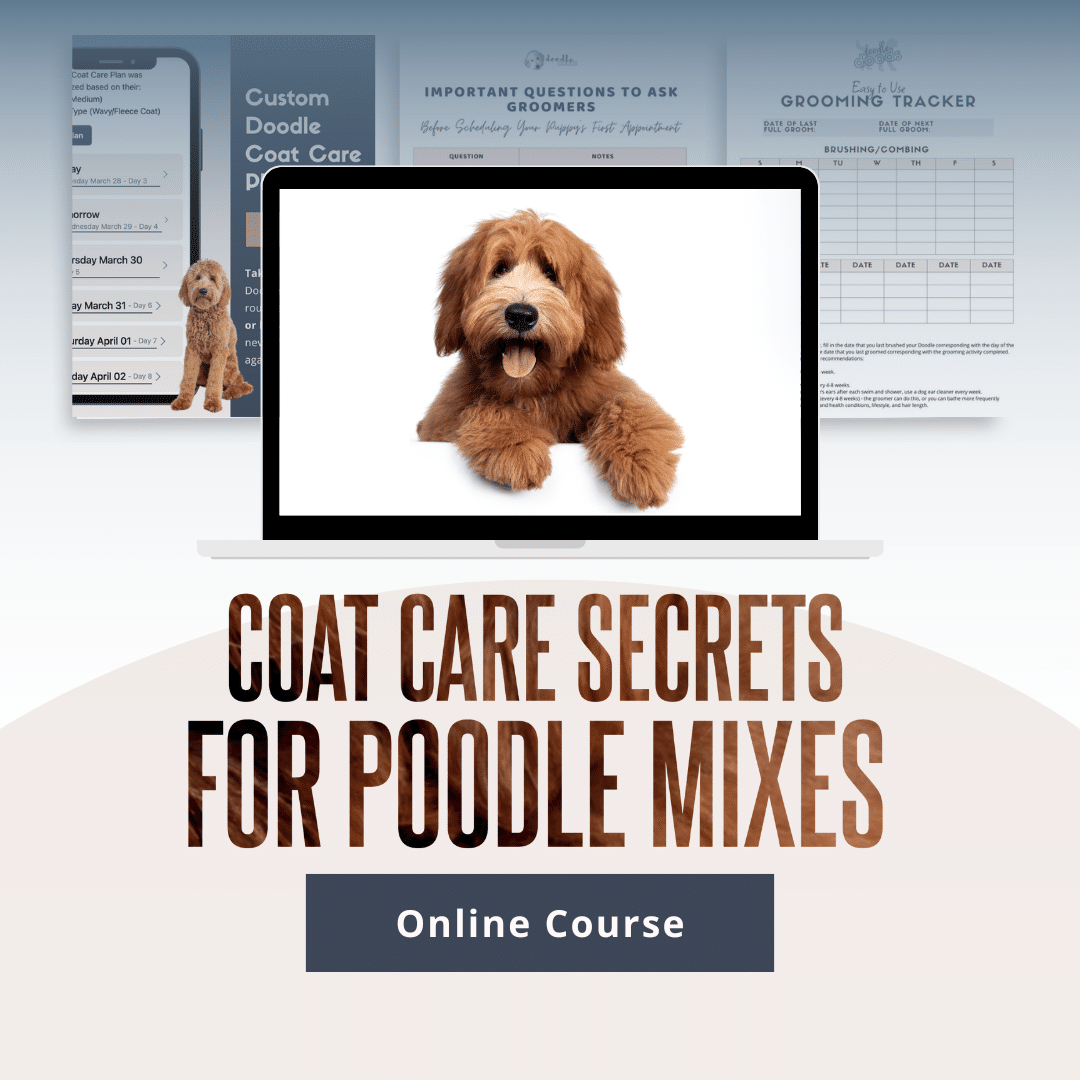
Discover the PROPER Doodle coat care routine that gets your pup to cooperate…helps you nip tangles in the bud…and gets groomers to do exactly what you want.
Plus, get $520 worth of Bonus Materials for FREE, including:- Doodle Parenthood Community and Support Group ($190 value)
- Custom Doodle Coat Care Plan Lifetime Access ($75 value)
- Easy to Use Doodle Grooming Tracker ($20 value)
- And MORE!

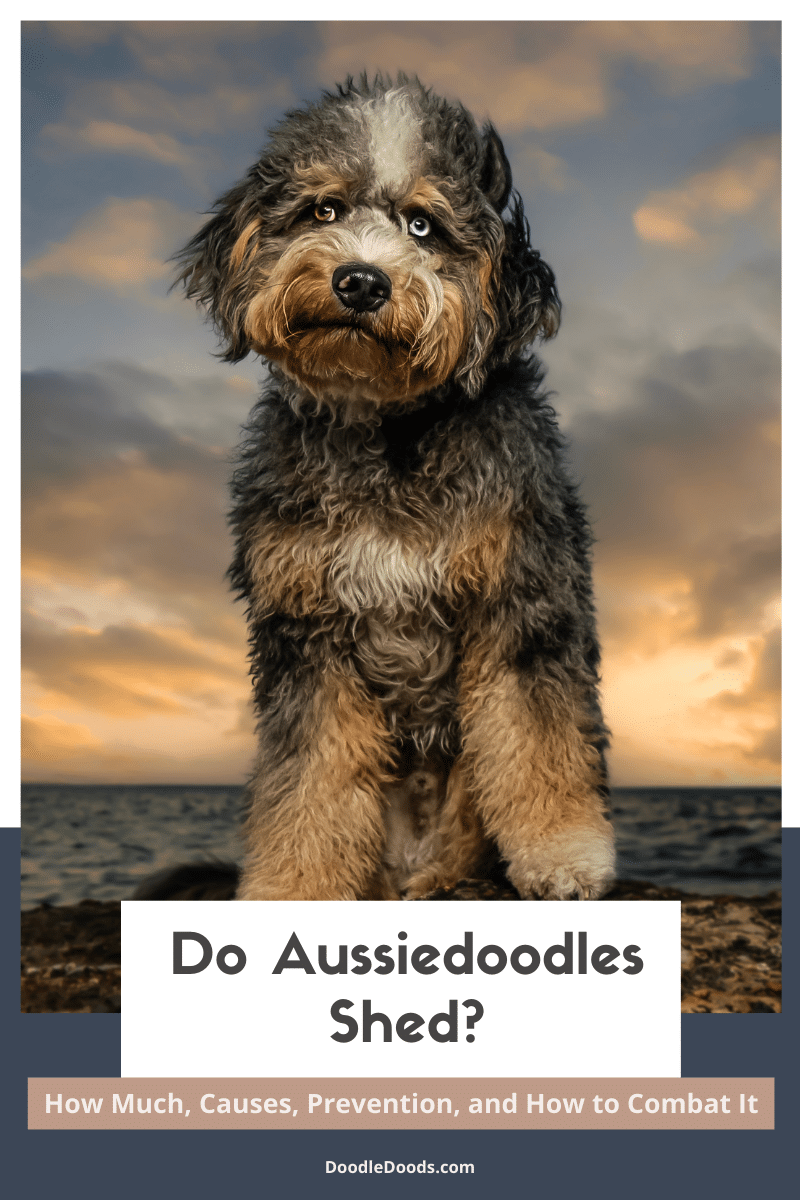
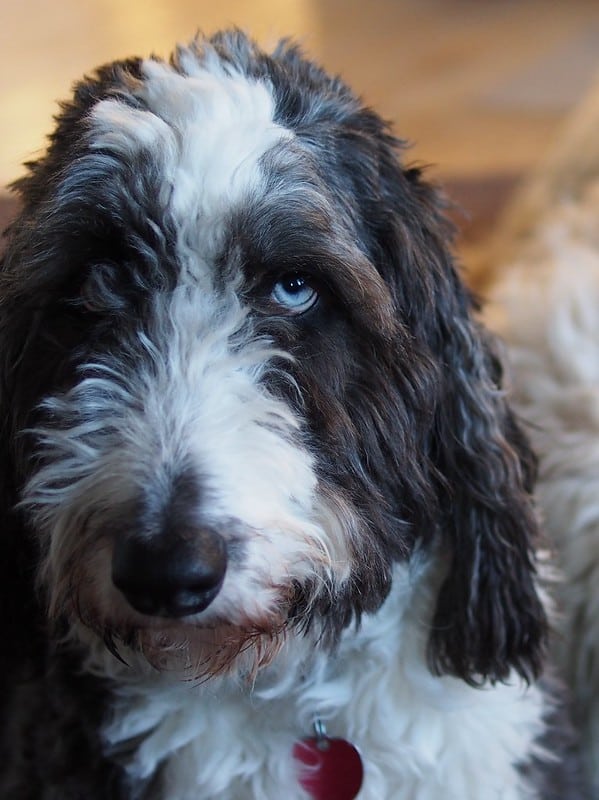
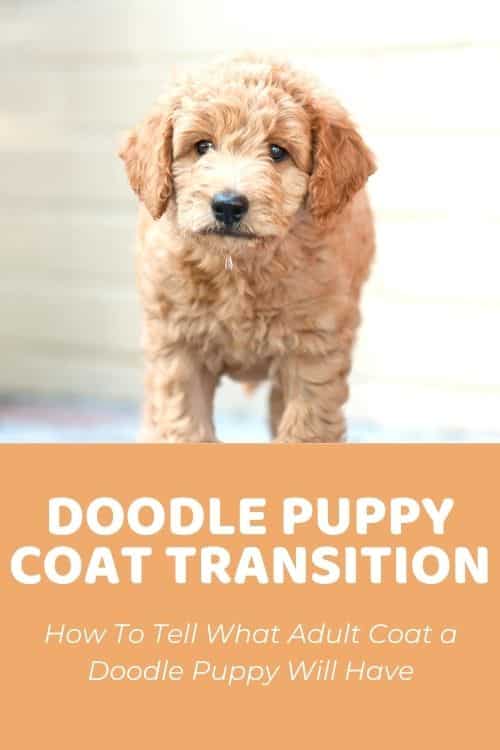
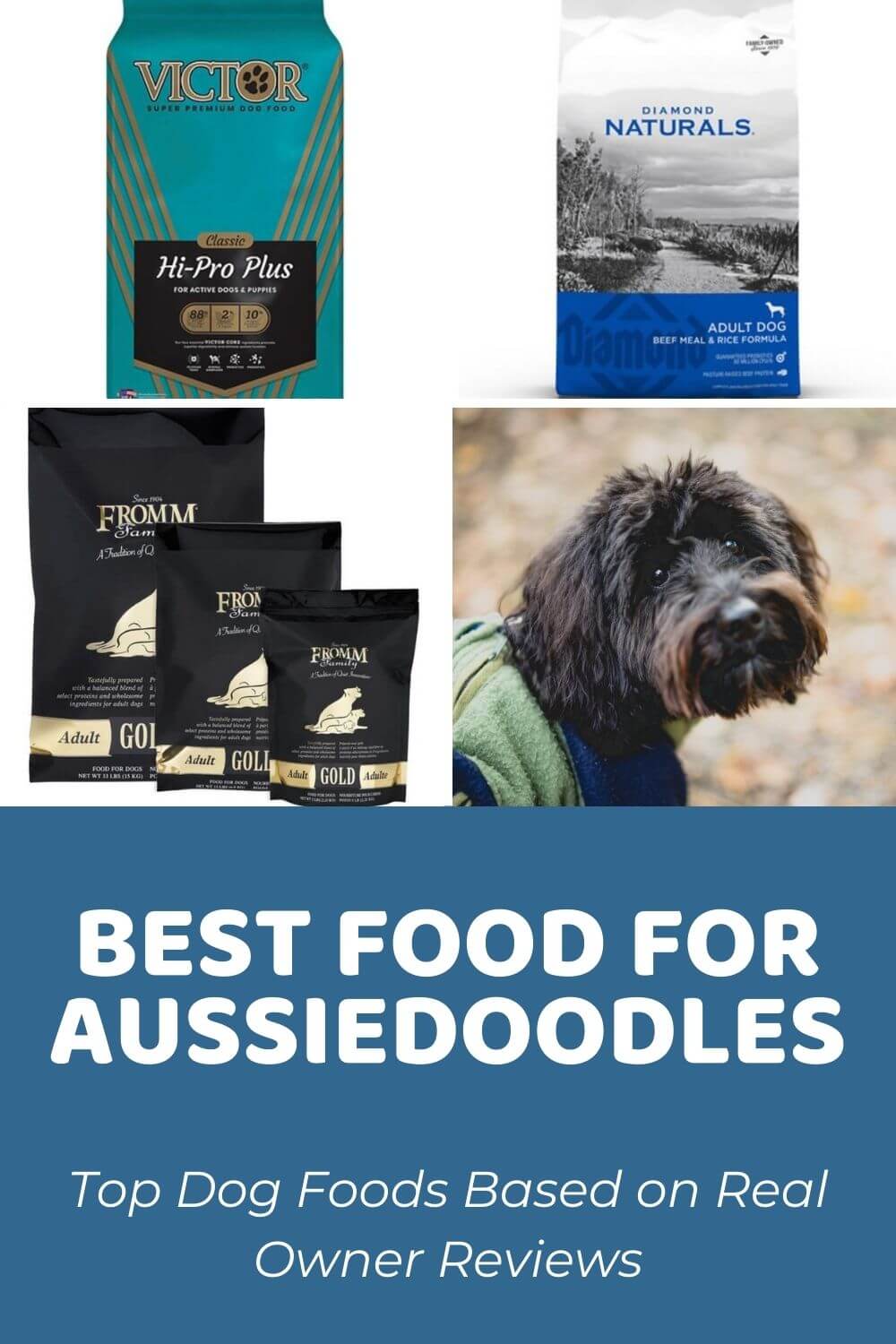
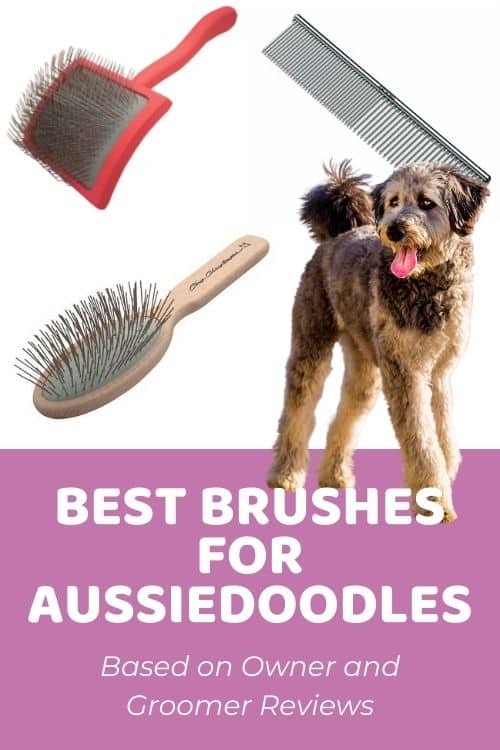


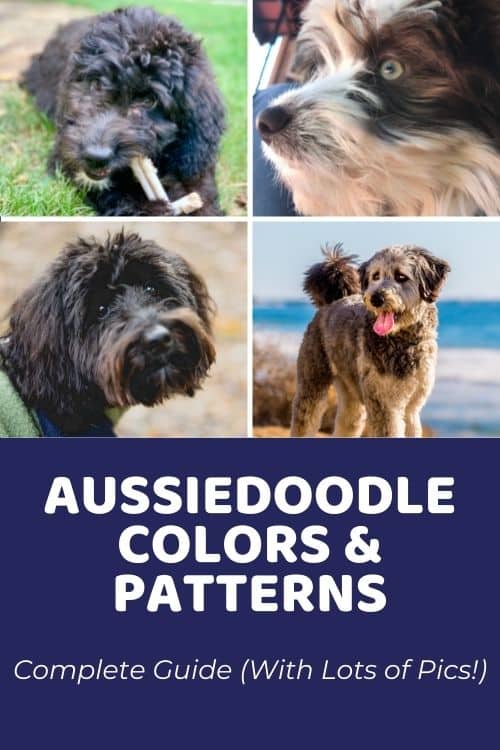
Your picture of the F1 Australian Shepherd in your generational chart is a golden retriever. Makes me wonder about the accuracy of your information.
August 5, 2022 at 6:45 pmWe use this same image everywhere on the website. It’s not meant to be breed-specific, it’s only to demonstrate what the generations mean.
August 6, 2022 at 7:19 am